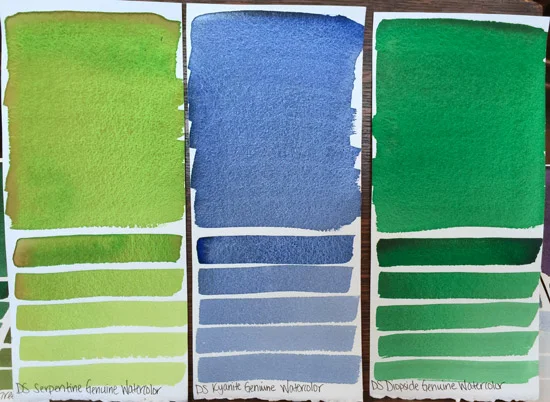As somebody who has studied geology in the past I'm intrigued by some of the minerals they're using. I love the names of the minerals.
What's also impressive is the level of information you get about each individual colour on the Daniel Smith website. Each colour gets an individual page with:
- an explanation about what makes the colour
- characteristics of the colour in terms of ASTM Lightfastness Rating, transparency, granulating and staining
Enjoy!
 |
| Daniel Smith watercolours - tonal value sheets and rocks |
- (top row) Lapis Lazuli (Lazurite), ?, Minnesota Pipestone, Hematite
- (bottom row) Rhodonite, Garnet, Sugilite, Serpentine, Malachite, Turquoise, Piemontite
Right click the image below to see a much bigger picture of the rocks.
 |
| DS Lapis Lazuli and DS Amethyst Genuine |
 |
| Daniel Smith Watercolours:(top row) Black Tourmaline Genuine, Bloodstone Genuine, Hematite Violet Genuine, Mummy Bauxite, Sicklerite (Bottom row): Hematite Burnt Scarlet, Burnt Tigers Eye Genuine, Tigers Eye Genuine, Minnesota Pipestone Genuine, Hematite Genuine (top right) Jadeite genuine |
 |
| DS Serpentine, DS Kyanite Genuine and DS Diopside Genuine |
I first tried them a long time ago and was immediately impressed with them - and I meet more and more artists who are adopting these paints as their brand of preference.
You can download a complete chart of all the colours they make from their website. This also provides comprehensive information about lightfastness AND the pigment used in each colour.
Many thanks to the Society of Botanical Artists who arranged for the presentation by the UK trade representative of Daniel Smith.

What a great day that was! I agree, fascinating to hear more about their origins. Hope you have fun trying out the paints in your goody bag!😉
ReplyDeleteI love the granulation of the Primatek pigments and enjoy using many of them for added texture and interest.
ReplyDeleteFeel free to delete this link, but you may be interested in seeing a paintout of all the Primateks here http://www.janeblundellart.com/primatek-watercolour-swatches.html (As well as all the other DS paints and hundreds from other brands)
ReplyDelete